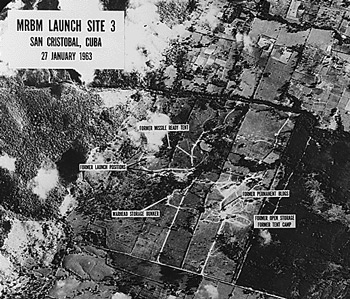Washington, DC: The Cuban Missile Crisis—13 days in October 1962—when the world teetered on the edge of thermonuclear war, is the subject of a new exhibition, “To the Brink: JFK and the Cuban Missile Crisis,” opening in October at the National Archives Building in downtown Washington.

The exhibition, coming on the 50th anniversary of that historic time, opens October 12, 2012, in the Lawrence F. O’Brien Gallery of the National Archives Building and will run through February 2, 2013. Admission is free. It then travels to the John F. Kennedy Presidential Library and Museum in Boston, where it opens April 12 and runs through November 11, 2013.
“To the Brink: JFK and the Cuban Missile Crisis” was created by curators at the Kennedy Library and designers from the National Archives, and features items from their respective collections. It is made possible in part by the Foundation for the National Archives, the John F. Kennedy Library Foundation, and the generous support of Lead Sponsor AT&T with special recognition to the Lawrence F. O’Brien Family.
Early in the Fall of 1962, Soviet Premier Nikita Khrushchev ordered a secret deployment of a nuclear strike force in Cuba, just 90 miles from the United States—with missiles that could reach most major U.S. cities in less than five minutes. President Kennedy emphatically stated that the missiles would not be tolerated, and insisted on their removal. Khrushchev refused. The standoff nearly caused a nuclear exchange and is remembered in this country as the Cuban Missile Crisis.
“To the Brink” is a look back at the crisis from the 50-year mark. The exhibit shows Kennedy and his advisers in the throes of deliberation during 13 agonizing days in October 1962, as the United States and the then-Soviet Union stood on the brink of nuclear war. The peaceful resolution of the crisis with the Soviets is considered to be one of Kennedy’s greatest achievements.
Featuring clandestine real-time White House recordings from Kennedy’s meetings in October 1962, the exhibit allows visitors to listen in on the government’s high level meetings as the President and his advisers worked furiously to avert a nuclear catastrophe. Original documents, artifacts, and photographs from the National Archives and its Kennedy Library complement the tapes in a dramatic presentation that engages the visitor into this milestone 20th-century event.
The White House Recordings
The President mobilized a group of advisers to help him navigate the crisis and sort through the ever-changing intelligence reports he was receiving. With the President guiding the discussions, they argued heatedly—and passionately—over the best course of action. Unbeknownst to almost all the participants, Kennedy had recorded those White House meetings.
The tapes comprise a valuable historical resource and a real-time glimpse back into the highest level of deliberations. They are the raw stuff of history and capture not only the options under consideration, but also the tension, anxiety, drama, and, at times, fatigue, that permeated the talks.
“To the Brink” offers visitors the chance to:
- Watch clips from Kennedy’s October 22, 1962, address to the nation, informing the American people of the Soviet arms buildup in Cuba.
- See JFK’s doodles from October 1962. Kennedy had a habit of jotting down words, notes, and doodles during meetings. These papers are now official records and are preserved as part of the President’s papers.
- Hear Kennedy and his advisers discuss and debate the crisis in “real time” as they view evidence of Soviet nuclear missile sites in Cuba and deliberate on how best to respond.
- Examine satellite photographs of missile sites under construction, images that were shown to Kennedy on October 16, 1962.
- Review CIA-prepared Personality Studies of Nikita Khrushchev and Fidel Castro.
- See the map of Cuba used and annotated by the President when he was first briefed by the CIA on the missiles. The President’s annotations mark the locations where the Soviets were believed to have placed nuclear weapons.
- Read secret correspondence between Kennedy and Khrushchev.
- See the original chairs used by Kennedy and Khrushchev during the 1961 Summit meeting in Vienna, Austria—the only occasion where the two leaders formally met face-to-face; they were photographed seated on these chairs at the U.S. Embassy in Vienna.
Follow the Cuban Missile Crisis in real time as the JFK Library tweets the 13 days: @JFKLibrary, hashtag #13Days.
The Archives Shop will feature an exhibition catalog and related products in conjunction with “To the Brink: JFK and the Cuban Missile Crisis.” All Archives Shop proceeds support the National Archives Experience and educational programming at the National Archives.
The Fall issue of Prologue Magazine, the Archives’ flagship publication, will feature an article by Martin J. Sherwin, a Pulitzer Prize-winning historian, titled, “One Step from Nuclear War, the Cuban Missile Crisis at 50: In Search of Historical Perspective.” Prologue is available in the Archives Shop.
The National Archives is located on the National Mall on Constitution Avenue at 9th Street, NW. Fall/winter hours are 10 AM-5 PM (September 4 through March 14). The John F. Kennedy Presidential Library is located in Boston.